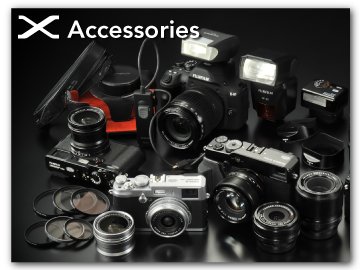Troubleshooting
Consult the table below should you encounter problems using your camera. If you don't find the solution here, contact your local Fujifilm distributor.
For the latest support information, refer to the following website.

- Power and Battery
- Menus and Displays
- Shooting
- Playback
- During Connection
- Wireless Transfer
- Miscellaneous
Power and Battery
Power and Battery
| Problem | Solution |
|---|---|
| The camera does not turn on. |
|
| The battery runs down quickly. |
|
| The camera turns off suddenly. |
|
| The camera does not turn off. | Check the indicator lamp (aThe Indicator Lamp). |
Charging
| Problem | Solution |
|---|---|
| Charging does not start (USB). |
|
| Charging is slow. | When the battery temperature is low or high, charging may be slow for safety reasons. Wait for the battery temperature to return to normal temperature before charging again. |
| The indicator lamp blinks, but the battery does not charge. | Clean the terminals with a soft, dry cloth (aInserting the Battery and a Memory Card). |
Power Supply
| Problem | Solution |
|---|---|
| The power supply icon is not displayed. | Confirm that POWER SUPPLY ON/COMM OFF is selected for USB POWER SUPPLY/COMM SETTING. |
Menus and Displays
| Problem | Solution |
|---|---|
| Display is not in English. | Select ENGLISH for DUSER SETTING > Qa (aChoosing a Different Language, aQa). |
Shooting
Basic Photography
| Problem | Solution |
|---|---|
| No picture is taken when the shutter button is pressed. |
|
Movie Recording
| Problem | Solution |
|---|---|
| Video recording ended unexpectedly. | Recording may stop if the writing speed of the storage media is slow. A list of supported storage media is available on the Fujifilm website. For details, refer to “Compatibility (Cameras)”. |
Continuous Shooting (Burst Mode)
| Problem | Solution |
|---|---|
| The burst shooting speed is slowed down. | The burst shooting speed may be slower depending on conditions such as lens type, writing speed of the storage media, flash use, exposure conditions, camera settings, remaining battery level, and temperature of the environment in which the camera is used. |
Panoramas
| Problem | Solution |
|---|---|
| No panorama is recorded when the shutter button is pressed. | Wait until the indicator lamps turns off (aThe Indicator Lamp). |
Face Detection
| Problem | Solution |
|---|---|
| No face is detected. |
|
Subject Detection
| Problem | Solution |
|---|---|
| No subject is detected. |
|
Flash
| Problem | Solution |
|---|---|
| The flash does not fire. |
|
| The flash does not fully light the subject. |
|
Abnormalities in Pictures Taken
| Problem | Solution |
|---|---|
|
The picture is out of focus. The picture is blurry. |
|
| The camera records images of things that do not exist, or the subject is recorded distorted. |
|
| Pictures are mottled. |
This is normal and does not indicate a malfunction. * Select HIMAGE QUALITY SETTING > PIXEL MAPPING. * X-rays, cosmic rays, and other forms of radiation interacting with the image sensor may cause bright spots of various colors such as white, red, and blue. Pixel mapping helps reduce the occurrence of such bright spots. |
| Noise is recorded in the picture. | Turn off the power for a while before using (aTurning the Camera On and Off, aTemperature warning). |
Playback
Full-Frame Playback
| Problem | Solution |
|---|---|
| Pictures are grainy. | The pictures were taken with a different make or model of camera. |
| Playback zoom is unavailable. | The pictures were created using RESIZE or with a different make or model of camera. |
Movie Playback
| Problem | Solution |
|---|---|
| No sound in movie playback. |
|
Deletion
| Problem | Solution |
|---|---|
| Selected pictures are not deleted. | Some of the pictures selected for deletion are protected. Remove protection using the device with which it was originally applied (aPROTECT). |
| Pictures remain after ERASE > ALL FRAMES is selected. |
Frame Number
| Problem | Solution |
|---|---|
| File numbering is unexpectedly reset. | The battery-chamber cover was opened while the camera was on. Turn the camera off before opening the battery-chamber cover (aFRAME NO.). |
During Connection
Connecting to TV
| Problem | Solution |
|---|---|
| The monitor is blank. | When the camera is connected to a TV, nothing will be displayed on the camera screen in playback mode. |
| No picture or sound on TV. |
|
Connecting to Computers
| Problem | Solution |
|---|---|
| The computer does not recognize the camera. |
|
Connecting to Smartphones
| Problem | Solution |
|---|---|
| Cannot connect to iPhones or iPads. | POWER SUPPLY ON/COMM OFF is selected for USB POWER SUPPLY/COMM SETTING. Select POWER SUPPLY OFF/COMM ON when the camera is connected via a Lightning connection to a device that do not supply power. |
| Cannot connect to smartphone. | The procedure for connecting the camera varies with the type of connector with which the smartphone is equipped (aConnecting to a Smartphone). |
Wireless Transfer
For additional information on troubleshooting wireless connections, visit:
aDigital Cameras FAQ
| Problem | Solution |
|---|---|
|
Cannot connect to smartphone. The camera is slow to connect or upload pictures to the smartphone. Upload fails or is interrupted. |
|
| Cannot upload images. |
|
Miscellaneous
Camera Operation
| Problem | Solution |
|---|---|
| The camera is unresponsive. |
|
| The camera does not function as expected. | Remove and reinsert the battery (aInserting the Battery and a Memory Card). If the problem persists, contact your Fujifilm dealer. |
Sound
| Problem | Solution |
|---|---|
| No sound. | Adjust the volume (aSOUND SETTING). |
Q (The Quick Menu)
| Problem | Solution |
|---|---|
| Pressing the Q button does not display the quick menu. | End TTL-LOCK (aTTL-LOCK MODE). |

 .
.

